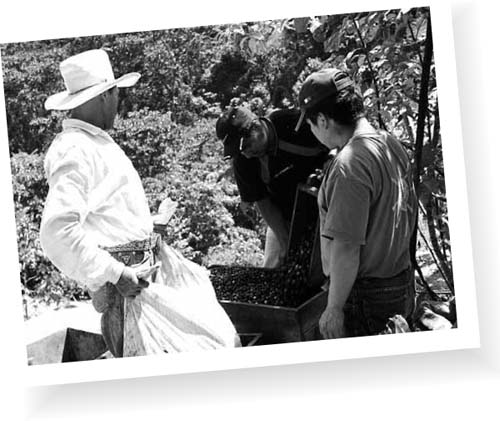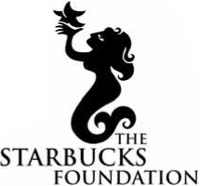The Starbucks Story (16 page)
Read The Starbucks Story Online
Authors: John Simmons

Much of this was building on what Starbucks had already been doing. As the executive who had the most contact with the coffee-growing regions, Dave Olsen had been building case studies and arguments for providing them with support. He established links with care, a humanitarian organization fighting global poverty, for which Starbucks has been one of the largest corporate supporters since 1991. The relationship started relatively small but has grown as Starbucks has grown, with the company contributing over $2 million to care’s programmes to fight poverty in coffee-growing communities. Projects to improve water systems, education and medical facilities have been funded in Nicaragua, Guatemala and many other countries.

Starbucks works directly with coffee growers
The Brazil frosts (which happened after the relationship with care had started) brought home that something more fundamental needed to be done. How could Starbucks tackle some of the basic causes of poverty in the coffee-growing regions? There were massive economic forces at work here; many other companies were shrugging their shoulders and saying “Not our problem.” Coffee is the world’s second most heavily traded commodity, after petroleum. Its economic power was apparent to the World Bank, which had encouraged many poor nations to move into coffee growing. This led to a world glut that soon started to drive prices down. As the farmers got less and less money, they were forced deeper into poverty. The only hope of salvation for many farmers is to produce the highest quality coffee that can be sold at a premium. Starbucks buys coffee in this premium range.
The large players in the coffee market have concentrated on buying coffee at the lowest prices on the commodity exchanges. A gap has opened between high-quality arabica coffee grown at altitude, and poorer-quality robusta grown on lower slopes. The figures show that 40 percent of the value of the world’s coffee is represented by 17 percent of its volume. Starbucks’ policy has been to secure long-term contracts with its coffee suppliers, establishing relationships in the mutual interest of the company and the farmers. So it pays prices that are substantially higher than the prevailing price of commodity-grade coffee. It negotiates prices that are independent of the commodity market, helping to provide stability and predictability for both buyer and sellers. The lessons of the Brazil frosts burned deep into the company’s psyche. Starbucks realized that it was in its own interest to ensure a sustainable supply of high-quality coffee.
To achieve that sustainable supply, Starbucks has pursued a number of strategies. These include building direct relationships with farms and cooperatives; negotiating long-term contracts; making affordable credit available to farmers; buying fair trade certified coffees, as well as certified organic and conservation coffees; and investing in health and educational projects that benefit the coffee-farming communities. Starbucks has also developed coffee-sourcing guidelines with Conservation International, an organization whose mission is to conserve the Earth’s natural resources and biodiversity. Under this framework, farmers who meet quality, environmental, social and economic criteria are rewarded with financial incentives and “preferred supplier” status. The arrangements are subject to independent audit.
Part of the strategy is to support fair trade, but Starbucks remains adamant that it selects its coffee first and foremost on the basis of quality. So it will not buy fair trade coffee that does not meet its quality standards. The reality is that the fair trade movement shares the same principles as Starbucks, helping to ensure that coffee farmers receive fair prices for their crops, but the fair trade system still accounts for less than 2 percent of the world’s coffee farmers. Fair trade is not the only way to ensure fair prices for farmers, but Starbucks supports it as one of its strategies. You can buy fair trade certified coffee in Starbucks in 19 countries, including the major markets of the US, Japan and the UK. Working with Oxfam, Starbucks is aiming to increase the supply of high-quality fair trade certified coffee from the 16,000 farmers who make up a large cooperative in Oaxaca, Mexico. When American activists organized a “National Call-In Day” against Starbucks, Transfair, the only certifier of fair trade products in the US, described the campaign as “particularly misguided and unfair because it ignores the company’s many important contributions to coffee farmers through fair trade and other programs.”
Starbucks undoubtedly feels picked on by protesters who ignore the facts. When it challenged one group “Why protest against us and not P&G?” the reply was “Because you care.” The anti-globalization protesters hurt Starbucks in a different way from, say, Nike, McDonald’s and Coca-Cola. Starbucks felt a real sense of injustice. It cared about the people who were part of its wider family: the coffee farmers and suppliers. It was hard to be attacked as a rapacious exploiter when it had always paid its partners higher than average wages, given them a valuable stake in the company, provided generous levels of health care, and taken the lead in supporting coffee farmers and their communities. Starbucks had put its own people at the center of its brand in a way that the protesters’ other targets had not. And the sympathies of many in Starbucks, coming from liberal, laidback Seattle, were probably close to the protesters’ views. When put together with Starbucks’ awareness of the European coffee house tradition to provide places for debate and radical thinking, it all raises the rather ironic picture of anti-globalization protesters gathering in Starbucks stores around the world to plan their next protest.
Without doubt Starbucks felt discouraged by protests and acts of vandalism against its stores. Many, including Howard Schultz, took the attacks personally and felt misunderstood and misrepresented. Starbucks’ response has simply been to plough on, continuing to build its support for coffee-farming communities and the neighborhoods where it locates its stores. Despite all the protests and bad publicity, it remains more committed than ever to good works, though there has been no public relations blitz to publicize them. Howard Schultz put it like this: “We can both do well and do good. We can be extremely profitable and competitive with a highly regarded brand, and also be respected for treating our people well. In the end, it’s not only possible to do both, but you can’t really do one without the other.”
For those who find sheer altruism hard to imagine, there is a compelling business case that all brands should note. We all have a vested interest in sustainability, even if we don’t recognize it. Starbucks does. Early in 2004, it announced that it was establishing the Starbucks Coffee Agronomy Company in Costa Rica. The new venture will have a team of agronomists, quality specialists and sustainability experts to ensure the future availability of high-quality sustainable coffee from Central America. It forms part of Starbucks’ effort to get beyond the exporter direct to the farmer, and was prompted by concern that farming practices and husbandry have been critically damaged by years of low prices. Starbucks is acting out of self-interest: it fears that in a few years’ time there might not be enough quality coffee available to sustain its projected growth rate. But self-interest and other people’s interest can coincide.
Indeed, this is the notion behind Starbucks’ practice of encouraging its partners to work in their local communities to support nonprofit organizations. If you understand this principle, you will understand much of the success of the brand. Satisfaction ratings among staff have placed Starbucks consistently in the top 10 percent of US employers. Material issues – pay and benefits – will account for much of this, but the efforts to encourage volunteering also count. People enjoy working with a company that they perceive as having a soul.
So Starbucks regards support for local communities as an investment: part of its business strategy rather than a series of charitable donations. But even at that level, the charitable donations add up to a major contribution. The way they are organized is characteristic: instead of having the board decide which charities to support each year, Starbucks gets its partners to nominate their favorite causes. The partners give their time and money, and the company supports them with money, materials and encouragement. In the US, two umbrella schemes support volunteering and the championing of nonprofit organizations by partners. The first, “Make your Mark,” matches a $10 contribution for each volunteer hour worked by a partner (or by the partner’s family and friends) for a cause of their choice up to a maximum of $1,000. In 2002, 68,000 hours of volunteer time were matched by a $433,000 Starbucks donation. The second scheme, “Choose to give,” matches Starbucks funding to an individual partner’s philanthropy. The partner chooses the charity and makes a donation; Starbucks donates the same amount and absorbs all the fees and administrative costs. In two years, donations by partners and by Starbucks have exceeded $1 million.
There are numerous other charitable initiatives, most of which originate at the level of the local store. But there are two particular corporate initiatives that tell us something about the Starbucks brand. The first is Urban Coffee Opportunities, a joint venture between Starbucks and the basketball star Magic Johnson. The aim is to open Starbucks stores in deprived, ethnically diverse neighborhoods such as Harlem in New York. Most of these neighborhoods have been neglected by business because of their poverty and social problems. When Starbucks enters the community, it lights a beacon for other retailers. The Starbucks stores provide employment and stimulate other business activities that would otherwise stay away. There were 35 of these stores operating in 10 states in 2003.
The second example of corporate philanthropy is the Starbucks Foundation, established by Howard Schultz in 1997 to provide funds for literacy programs. The Foundation encourages volunteering, and provided $1.7 million to schemes in 2002. It has given grants of $6 million to 625 nonprofit literacy causes since it was set up; the UK National Literacy Trust venture described earlier in the chapter was one of its beneficiaries. One of its most striking activities is Jumpstart, which matches volunteer college students with preschool infants from low-income communities. Together, and with support from Starbucks partners, they build children’s early language, literacy and social skills.

Magic Johnson
Part of this is no doubt fuelled by Howard Schultz’s origins in Brooklyn. He experienced first-hand what it means to grow up in a neighborhood that has been deprived of economic sustenance (and the hope that it brings). Even so, American corporate history is full of people who make good despite the economic disadvantages of their upbringing, yet very few of them feel the same need to give something back to the kinds of neighborhood from which they came.
The real power of Starbucks’ approach is that unlike the paternalistic business benefactors of the past, Starbucks does not simply dish out money and then stand back. It does give money, but it also encourages its partners to be active in bringing about beneficial change in their communities. This creates an energetic network, a dynamic movement that produces effects beyond the reach of purely financial donations. Starbucks realizes that, for good to come about, good people need to do good.

